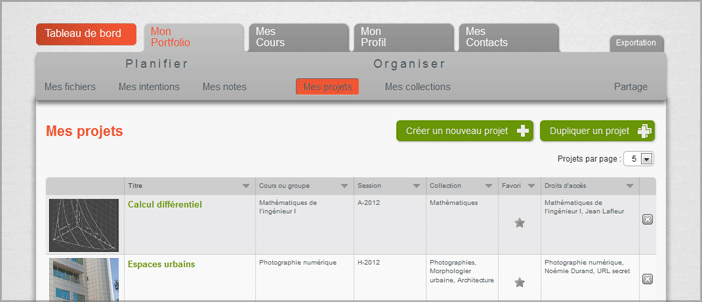The SHERPA Digital Learning Portfolio is …
As a project of the Programme de Collaboration Université-Collège (PCUC-MESRST), the initial SHERPA project brought together more than 20 college and university programs in the visual arts field from the Quebec City region. They initiated a consultation process to plan the production of a digital portfolio suitable for educational programs within all branches of higher education.
The systematic identification of needs expressed by students and teachers as part of this consultation resulted in the selection of indicators, production goals and information processing tools applicable in diverse contexts and teaching practices for both levels of higher education.
The resulting portfolio application’s objectives are to support learning and to track skill acquisition, as well as to highlight the value of a student’s work. Designed to be an integral part of the academic process, it can not only serve as a bridge between various levels of education, but as a career development resource as well.

An example of the SHERPA control panel.
…customized
The SHERPA design is based on a flexible and scalable public domain infrastructure called Mahara, enabling a simple and user-friendly academic environment. The portfolio’s objective is to continuously document academic and real-life learning. It is compatible with the Moodle environment and can be exported to another environment in accordance with the Leap2A standard as well or exported in HTML format for publication on a website.
SHERPA also provides access to a social networking environment where information and achievement sharing is facilitated. In this regard, several tools are available to users, such as group project spaces for collaboration, discussion forums and advanced sharing options for project production.
SHERPA’s user management options enable the creation class-based groups (created and administered by the institution, moderated by a teacher) as well as interest groups (administered by the school but created and moderated by users). If required organizationally, a school could group users in a shared workspace, organized and moderated by a teacher. This arrangement allows for efficient transmission of course information as well as the evaluation of projects, while complying with confidentiality requirements and standards.

Flow chart for user mastery of SHERPA (in French).

Schematic of partner roles for SHERPA (in French).
…documented
An information space (info.sherpaportfolio.ca), which is independent of the portfolio itself, has been created. The English edition of this information space will be going online in January 2013. This help feature clarifies and provides documentation about the development and use of SHERPA. Ultimately, it will provide support on points such as implementation strategies for academic disciplines and programs and integration scenarios for specific courses or learning strategies, as well as other examples, illustrations and models useful in integrating an educational portfolio. This information space will be a reference source as well as a tool box to enrich the use of the portfolio in multiple situations.
SHERPA can support the contributions of different categories of users such as students acquiring skills, graduates in the labour market and educational professionals (teachers, counselors, administrators ) in institutions of higher learning, enabling instructional planning and admissions management as well as academic curriculum planning.

…and well supported!
In order to make SHERPA available to all institutions, the establishment of technical, pedagogical and technological resources was required to ensure up-to-date resources and quality service for users. A number of IT Partners are coordinating their efforts to further this goal.
APOP will give frontline support with educational activities for the new user as well as continuing education on the academic use of the SHERPA teaching portfolio. Users will be supported in the planning of scenarios and strategies tailored to specific learning situations. As of November, these activities will be offered online. Newsletters and the APOP website will keep you informed of the workshop schedule.
DECclic will assume the role of system and registration administrator in charge of hosting and updating SHERPA. Given the compatibility of SHERPA with the Moodle environment, users can access it directly from the DECclic Moodle interface. Access to SHERPA will also be possible from the portfolio information space.
Profweb will ensure the dissemination and sharing of information about the use of the portfolio with the communication space (info.sherpaportfolio.ca), activities around the theme of the digital portfolio, the publication of stories about teachers who have used a digital portfolio in an academic context as well as other activities to enrich resources available to the academic community. A story produced by a teacher who used SHERPA is available in French and English!
The Vitrine technologie-éducation (VTÉ) will continue to monitor digital portfolio technology in an educational context. It will host a Laboratoire vivant, in November on the subject. The activity, which will be in French, will include an overview, sharing, tools, presentations of research results and discussions spread over four sessions. Visit the VTE website for full information.
One way or another, SHERPA is coming into our academic environment. The social constructivist approach, on which the digital portfolio is based, is motivating, whether as part of a program or for communicating this motivation to students. The English version of SHERPA will be available in January 2013.
Why not start getting to know the many aspects of SHERPA better by participating in the various activities on the subject being undertaken by participating IT partners.

